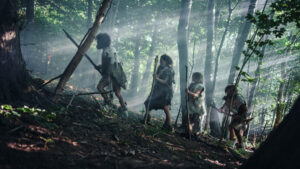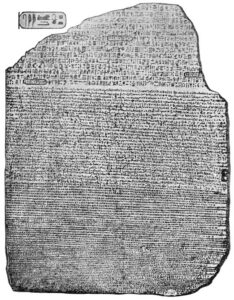

Archeology draws on science, the humanities, social science, and anthropology to answer a fundamental question that pertains to culture, religion, and philosophy: where did we come from? It’s a perfect field to study in the context of a liberal arts education.
Archeology has made great strides over its relatively short existence. Concepts like historical preservation and scientific inquiry into past ways of life didn’t begin to take root until the Enlightenment in the 17th century.
What is Archeology?
Archeology is defined as the study of past humans by recovering and analyzing the physical objects that surround them. This is especially relevant for the study of pre-historic humans, a story that is still largely shrouded in mystery.
Writing has only been around for several thousand years, whereas modern humans have been around for somewhere around 200,000 years. Archeology is vital for understanding how prehistoric humans lived, and to understanding the 99 percent of our human history that has not been written down, as well as the one percent that has.
Filling the role of historical detectives, archeologists find artifacts, human remains, animal remains, tools, trash, and buildings to piece together a puzzle about how people of the past lived and interacted with their environments.
Archeology isn’t always like Indiana Jones. Archeologists spend their time doing things like:
- Meticulously surveying dig sites and cataloging recovered items
- Sketching and mapping potential finds and dig sites
- Researching the history of the people who lived at an archeological site to enable the best interpretation
- Cleaning fragments of pottery
- Paperwork: keeping records on the inch-by-inch discoveries made every day
- Extensively using hand shovels and trowels
- Photographing everything
Archeology Versus Culture: A Debate For Liberal Arts Grads to Hash Out
 When and how humans first arrived in North America has been a hot topic in archeology ever since the theory of the Beringia land bridge was first proposed. In archeology it’s widely accepted that the first people to populate what are now known as the North and South American continents made their way across the Beringia land bridge, coming from Siberia to present-day Alaska somewhere between 15,000 and 20,000 years ago.
When and how humans first arrived in North America has been a hot topic in archeology ever since the theory of the Beringia land bridge was first proposed. In archeology it’s widely accepted that the first people to populate what are now known as the North and South American continents made their way across the Beringia land bridge, coming from Siberia to present-day Alaska somewhere between 15,000 and 20,000 years ago.
Just this idea alone is already incompatible with some Native American religious explanations about how lands in North and South America originally became populated with humans. And this is just the beginning of controversy.
Historically, American European-descendant anthropologists and archeologists who have worked with Native American tribes have done so in a way that was disrespectful and condescending in the wider context of a culture that had been oppressed by a more domineering culture. In recent history, the concept of cultural sensitivity effectively did not exist.
Moreover, as archeologists uncovered evidence of successive waves of migration to the Americas it was not unheard of to conclude that some Native American tribes were not related to the original inhabitants of the land they called their home, creating further tensions.
There is also a longstanding grievance many Native American tribes have against archeologists regarding artifacts and human remains. Many Native American cultural traditions and religious teachings say that funerary artifacts and human remains must remain buried. Many tribes are hesitant to allow archeologists to disturb burial grounds on their lands. And there’s a related ongoing issue of tribes trying to gain repossession of artifacts and human remains they say were stolen from them by archeologists.
Cultural sensitivity and respect for the rights of Native Americans has grown in recent times and led to the passage of laws like the Native American Graves Protection and Repatriation Act. However, as more sites on Native American land are restricted from archeologists, archeologists make the point that forbidding the excavation and study of some sites is restricting our knowledge of ancient cultures and pre-historic humans.
Both sides have legitimate points. The debate highlights the fact that it can be difficult for things like science, religion, and cultures to co-exist. And this is why the liberal arts context is so relevant. The liberal arts is the best intermediary for facilitating conversations that respect science, religion, and culture, and resolving tensions in a way that’s considerate and respectful of everyone involved.
Specializations Within Archeology
Archeology is a broad field that has many areas of specialization. These incorporate a gamut of strategies for understanding the past, ranging from experts of the very old to the very new.
Ceramic typology is an example of experts of the old. Many prehistoric human civilizations used pottery vessels to store and transport valuables, and ceramic typologists specialize in linking pottery with the past cultures who designed and used them. In some deserts ceramic typologists can simply walk for miles and come across the remnants of different cultures that spanned thousands of years in the form of ceramic shards.
Hand-held x-ray devices are modern machines on the market today. They can do everything from analyzing layers of a dig, to looking inside mummified remains, to using fluorescent spectography to determine the elemental components of an artifact.
Environmental archeologists attempt to reconstruct human archeological sites based on what can be observed in the local environment, including botanical remains, animal remains, and geological remains such as those showing activity of mining or quarrying.
Just like archeology itself, the specializations within this field are by their nature multi-disciplinary, making them perfect for a liberal arts context.
The Rosetta Stone – An Archeological Story Best Told by the Liberal Arts
 Perhaps no other archeological discovery has been more significant than the Rosetta Stone. And the background of this discovery is explained in rich detail within the context of a liberal arts education.
Perhaps no other archeological discovery has been more significant than the Rosetta Stone. And the background of this discovery is explained in rich detail within the context of a liberal arts education.
Sparked by the success of the American Revolution, towards the end of the 18th century Europe was seeing pitted battles between republicans, monarchists, and nationalists. Napoleon was prominent among these belligerents, and in 1799 the French forces he led came across a stone slab laying near an old Ottoman fort they were fortifying in Egypt.
Up until this point the hieroglyphs of the ancient Egyptians had been indecipherable, knowledge that had been lost since at least the Middle Ages. The day’s archeologists knew there must be meaning behind the symbols but they had not been able to crack the code. But at that time, all Egyptian writings dating between the 28th century BC and the 5th century BC –writings from a period spanning more than 2,000 years– were undecipherable.
The Rosetta Stone finally put an end to this mystery, making it possible for the ancient Egyptian script to be read again in the 19th century AD – nearly 5,000 years after the first sentence in Egyptian had been written. The stone had three translations of the same text: one version in ancient Egyptian hieroglyphs, one version in more recent Egyptian Demotic that was a kind of written form of the spoken language, and one version in ancient Greek, the latter of which was known to the scholars of the time.
And when it came to the actual content: the Rosetta Stone contained a decree by the king of Egypt saying he’d cut taxes and that he should be worshiped by his subjects, notions that are perfectly familiar to us today. Taxes are still around, and the cult-of-personality is still a favorite tactic of many politicians.
It’s a classic story for the liberal arts: archeologists under the service of revolutionary Napoleon used their knowledge to put the writing on the Rosetta Stone in its proper context. Its message represented a bridging of cultures and languages to solve a millennia-old mystery whose message was a political commentary that’s just as relevant in the present as it was in the past.
And there’s a post script to the story. Egypt wants the Rosetta Stone returned for its own museum, while its current wards at the British Museum refuse to hand it over. So far, the position of the British Museum is supported by more than 30 of the world’s leading museums including the Metropolitan, the Louvre, the Hermitage, and the State museums of Berlin. They’ve endorsed a statement that says, “museums serve not just the citizens of one nation but the people of every nation.”
It’s a familiar debate over repatriation of an artifact that highlights the compounded importance of studying archeology in a liberal arts context.





